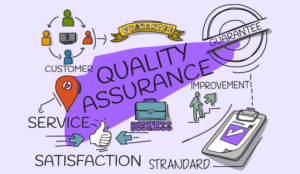Nico Bryan of Playvox shares her advice for improving your contact centre quality assurance (QA) programme.
Customer experience is more than a trendy buzzword these days – it’s a customer service necessity.
As consumers increasingly rely more on self-education through the purchasing journey, their decision to become a customer often comes down to the strength of your support team.
According to American Express, one-third of consumers say they would consider switching companies after just one instance of bad customer service.
No matter what your business offers, creating a positive and helpful customer experience is vital to thriving in an ever-shifting and crowded marketplace.
It should come as no surprise that a solid quality assurance programme is the key to a great customer service foundation. But is that enough?
The brands most poised to compete utilize a dynamic quality assurance programme to set themselves apart from their competitors.
If you’re looking for creative ways to elevate your quality assurance programme, you’ve come to the right place. In order to take your call centre quality assurance to the next level, there are a few things you should consider when enhancing the effectiveness of your programme.
1. Brand Your QA Programme
“Your personal brand is a promise to your clients… a promise of quality, consistency, competency, and reliability” – Jason Hartman, author of “Become the Brand of Choice”
Consumers are short on time these days, which means you and your competitors are fighting for that one second of a customer’s attention. Establishing your brand is vital to how emotionally invested a customer becomes in a business and how well they understand what that business stands for.
The same can be said for your customer service team members. It is important for them to understand what they should stand for and what is expected of them when offering quality customer service. More important than technical and academic information, you want these values to stick in their minds and become a part of every interaction they have with customers.
According to Statista, 34% of customer service leaders feel their quality assurance programme is only somewhat optimized. Meaning, there is a lot of room for their QA programme to grow into a driving and bold force within their customer service operations.
The first step in the right direction is to brand your quality assurance programme. You can accomplish this through a four-pronged approach: establish key values, define those values, arrange the values as an acronym, and create a logo to represent them.
- Establish key values: You must first ask yourself: What makes a great customer service person in our organization? Choose 3-6 words that represent the main values you look for. These should be specific areas with which you evaluate and measure your customer service employees.
- Define those values: After you have chosen your values, give them specific definitions and cluster them around important themes and examples. Take the time to establish these, as this is the perfect opportunity to ensure that each value is different.
- Arrange the values as an acronym: An acronym is a type of mnemonic device that helps a person improve their ability to remember something. They are fun and easy ways for your quality assurance and customer service teams to remember your values.
- Create a logo to represent them: Ben Segal, Associate Director of Customer Experience at Freshly, suggests a logo to tie it all together: “It’s important to make the branding memorable. If you want to be cute, you could even make a logo. This is helpful when it comes to recognizing success in the programme. Imagine certificates of achievement with the logo in the header.”
2. Hire Creatively and Promote From Within
Unlike traditional quality assurance models, a dynamic QA programme needs to have the right people for the job, since you need them to be thoughtful in their judgements and apply established standards with the utmost level of confidence. The more elaborate the QA programme, the more weighted and complicated your expectations will be.
With more complicated and weighted expectations, the reliability of your QA team is essential. This goes beyond standard rule and process following. Your QA team needs to be composed of ambitious and considerate individuals who can think beyond the established operating procedures and offer insight to their job functionality.
People who are tasked with monitoring agent contacts need to be invested in your QA values and ideals. But how do you find and train the right people?
- Promote from within: Current employees make the best employees. A survey by McKinsey & Company found that promotional opportunities account for 14 percent of an employee’s satisfaction, coming in at second overall for agent retention. Whenever you can, hire your QA team members from the frontline of your customer service department. An enhanced QA programme requires a certain level of emotional connection and commitment to your brand, which can be difficult to find in new hires.
- Keep your QA involved with the frontline: Frontline work should not just be reserved for customer-facing team members. Make sure when you hire or promote your QA team that they continue spending time doing frontline customer service work. It is crucial for your QA specialists to intimately understand customer needs and pain points, as well as understanding the reasoning and actions behind the agents they are rating.
- Prioritize qualities according to your established values: When on the search for your next QA specialist, find someone who understands the specific relationship you want to have with your customers. You are looking for someone who understands the immaterial aspects of quality. Shift your sole focus away from those who have extensive contact centre experience and look for people who offer unique perspectives and come from different industries or fields.
- Have a strong training programme in place: If you’re taking your QA programme to the next level, be proud of it and invest in it. The more involved the QA programme, the more information there is to learn. In order for your quality foundation to be applied correctly and consistently, robust training should be a key component of your programme.
3. Break Out of the Linear QA Box With Soft Skills
Traditional QA programmes can be rather linear. They are inherently limiting in nature, checking as to whether a customer service representative followed X, Y, and Z protocol.
While these protocols are important, they are not everything and have little to do with the emotional connection your customers feel towards your company, product, or service offering.
Soft skills are a great way to offer your agents more learning opportunities and can take your QA outside of the box.
Many soft skills are rooted in emotional intelligence, such as empathy and creativity. According to research by TalentSmart, high-performing customer service agents are the No. 1 scorers for emotional intelligence.
Some useful soft skills to consider are:
- Empathy: Empathy is a less tangible factor that can influence a customer’s experience. Customer service is built around caring for the customer. The ability of your customer service agents to proactively put themselves in the customer’s mindset should be the most important soft skill you look for and expect.
- Innovativeness: The more robust a quality assurance programme, the more imperative it is for your team to be forward-thinking in their judgements. Customer service is not one-size-fits-all, so a simple cookie-cutter response will not handle every situation or problem that arises. Agents need to have the innate drive to want to look for solutions to help, and QA specialists need to use their subjective judgement to ensure the agent did the maximum possible effort to solve problems and provide answers.
- Creativity: Creativity may sound a lot like innovation but it’s very different. While being forward-thinking is the driving force behind turning thoughts into action, creativity is how we form those ideas. Encourage your team through creative problem-solving activities and empower them to think outside the box.
4. Move Away From Binary Thinking and Monitor With Compassion
Creating an enhanced QA programme means looking beyond the simple yes or no checklist items, again, breaking away from the linear nature of quality assurance. You need to create standards and structure for which contacts are being monitored and how they are being monitored.
Less tangible, more subjective judgements are necessary for creating a strong customer experience such as holding empathy for the agent experience during monitoring.
Breaking the binary mould will help you monitor more kindly, more strongly, and more subjectively.
- Coach More, Ding Less: Find more opportunities for coaching your agents than for deducting. Making feedback a more fluid process and not holding agents to unreasonably strict standards will improve their experience and thus create a foundation of empathy for your QA programme. Leverage your quality assurance to find opportunities for coaching by removing strict questions that may be worded poorly or are not helpful to the agent–customer relationship.
- Find Your Monitoring Frequency: You can only expect your agents to live and breathe your QA programme if you introduce it into their work sufficiently frequently. You should work to conduct monitoring cycles at least once every two weeks or every week. This ensures that your QA reviews become a regular part of the agent experience. These cycles should then be followed up with meetings, so the agent has the proper time to absorb their results.
- Monitor Subjectively: Subjectivity in monitoring is key to amplifying your quality assurance programme. The worst-case scenario you could subject your programme to would be to have someone listening to a call for QA while sitting next to the person conducting the call in real time. The situation can be made worse if the person monitoring has a question and is forced to ask it in front of the frontline staff. This can create a toxic work environment for both the QA team and agents. Even further, personal relationships at work can cloud the entire QA process. That is why separation between the two parties is necessary. This can be accomplished by separate rooms, separate office buildings, or working remotely.
Conclusion

Nico Bryan
Enhancing your QA programme will not only help to improve the quality of customer contacts but it will effectively improve overall customer satisfaction.
Creatively improving QA inspires customer service agents to be more mindful of how they’re treating the customer and how they’re representing the company.
Since agents are rated and rewarded continually, there is sustained momentum and improvement over time.
To find out more visit: https://www.playvox.com
Author: Robyn Coppell
Published On: 11th Sep 2020 - Last modified: 21st Aug 2023
Read more about - Guest Blogs, Playvox





































